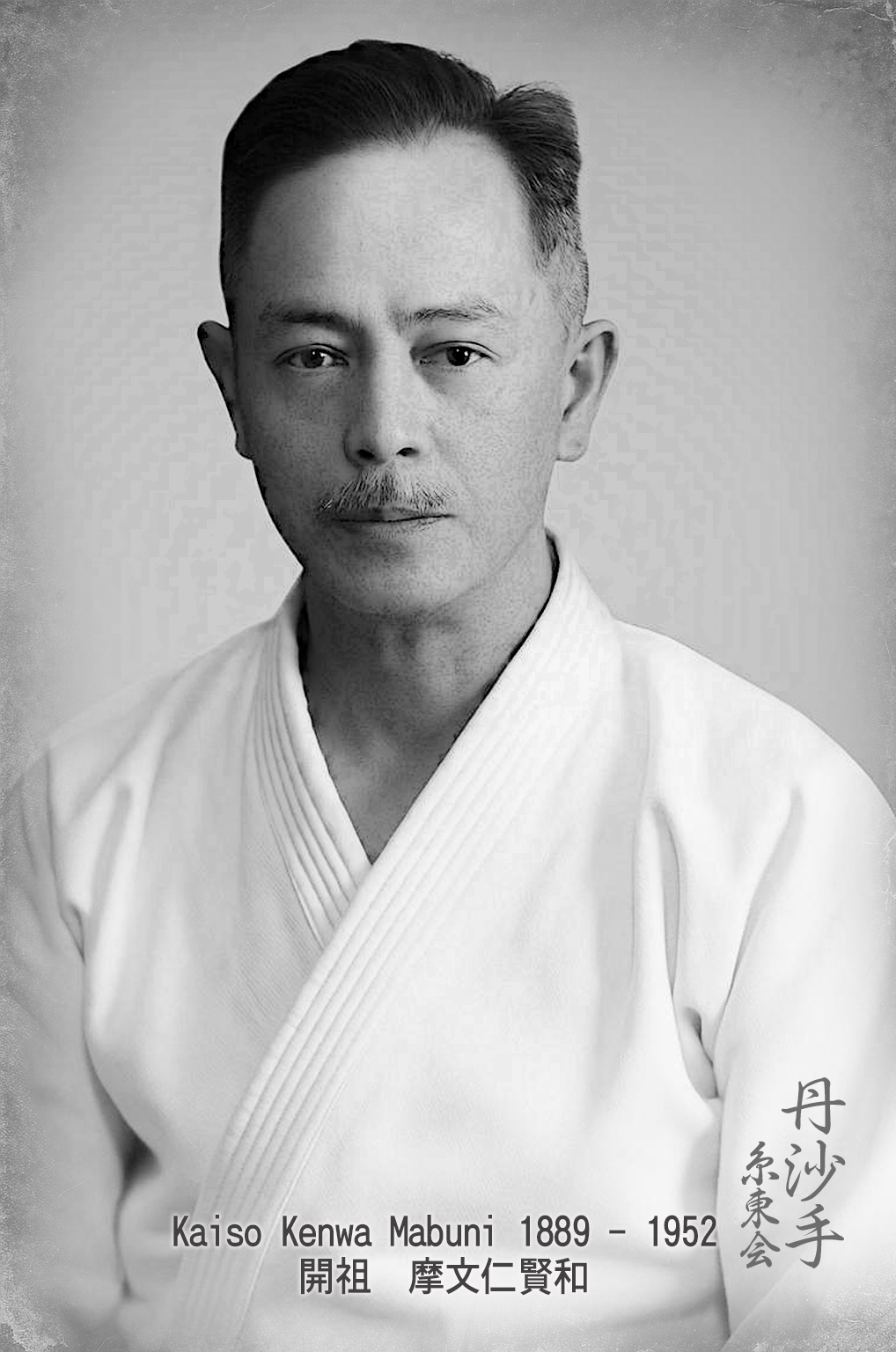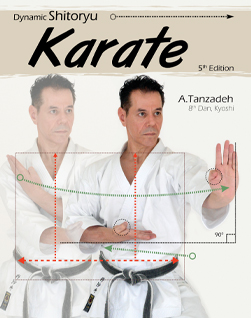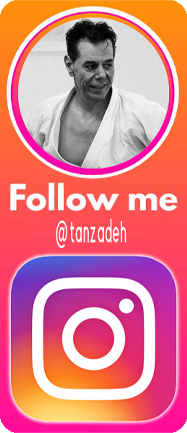«Kaiso» (Founder) Kenwa Mabuni, creator of Shitoryu Karate
The descendant of warriors of Ryukyu from the kingdom of a noble king Kenio Oshiro, the founder of karate-do Shitoryu, Master Kenwa Mabuni was born on November 14, 1889 in Shuri, Okinawa. As a Kenio family successor, Master Mabuni used a hieroglyph “Ken” – “Clever”, “Wise” which later on was applied as a principal in Shitoryu schools and its philosophy and by that Kenwa Mabuni meant “Wise and Harmonious”.
Master Kenwa Mabuni got inspired by the stories told in his family about his famous ancestors. Being physically weak as a child, he decided to forge himself through developing physical power of his body. At the age of 13 in 1902, Kenwa became a student of karate-do under Master Anko Itosu who lived in Shuri and by that time had a reputation of an outstanding and prominent teacher of martial arts. Master Anko Itosu gained his knowledge while training the skills under karate greatest masters, Sokon Bushi Matsumura and Kosaku Matsumora.
Anko is a nickname that Itosu was given due to his ability to walk in a horse stance. Having a huge chest and incredibly strong shoulders, arms and jaws, Itosu could withstand the strikes of other masters with no visible damage to himself developing a powerful body and spirit.
Grandmaster Anko Itosu was born in 1832 in Shuri, Okinawa and died in March, 1916. During his life time, Anko enormously influenced most of the styles of Shorinryu Karate families.
Grandmaster Anko Itosu has created his own philosophy which he used to explain through the following principles:
“Karate teaches us not only to develop the body, but also to defend ourselves, help everyone and never fight for a reason. If you are learning karate, Do not wave your arms and legs, look straight, lower your shoulders, the body must be tough as it is on the battlefield. By performing kata, it seems that you are face to face with the enemy. Always focus on everything around. Strong-willed people will always prefer peace and love. So the more you practice karate, the more you should become modest …”
Master Kenwa passionately dedicated himself to hard training with Master Anko Itosu and within seven years he learned the art of Shuri-te. As his first and main teacher, the great master Itosu transferred the secrets of 23 katas to Kenwa Mabuni.
At the age of 20 after graduating from high school and after 2 years of service in the army, Master Kenwa Mabuni followed the recommendation of his close friend, Master Chojun Miyagi, founder of Gojuryu Karate and began to study the art of Naha-te with the Grandmaster Kanryo Higaonna.
Master Higaonna was born on March 3, 1853 in Nishimura village in Naha at the time of
occupation of the Okinawa Island by the Satsuma Clan of Japan. His family belonged to the low-rank nobility. Master Higaonna was the fourth son in a family of six children.
Higaonna had his first martial art experiences at the classes under the instructions of Master Aragaki Seisho in 1867.
Master Aragaki was born in 1840 in either Kumemura, on Okinawa Island, or on the nearby island of Sesoku. The name of Master Seisho Aragaki who lived in Kume during the years of 1840-1920 was well known among Okinawans for his Kata called Seisan. For his extraordinary physical capabilities, Master Seisho Aragaki was given the name of Cat or Maya, his jumps were as soft as a cat. His second nickname, Aragaki Kamadeunchu, was given to him for his hands (“kama-de” means “sickle hands”) and also the kata “Unshu” that he created. The name of Seisho Aragaki can be referred to several weapons and katas that he developed to be applied against the sword such as Bo and Sai being used in some katas including Aragaki-no-kun, Aragaki-no-sai and Sesoku-no-kun.
Grandmaster Kanryo Higaonna returned to Okinawa in 1881 after 13 years of diligent study with his Ryu Ryu Ko.
The Naha martial arts that Higaonna was practicing became known as Naha-te (also known as Tode). Kanryo Higaonna kept teaching this art to students in Okinawa and at the same time continued his own research and tried to practice constantly and developed new methods focused on enhancement of mind and body skills for young students and helping to improve physical and spiritual well-being. One of the most valuable outcomes was the popularization of Chinese martial arts among the people in Okinawa.
Gaining the knowledge and learning experience from the two main grandmasters Anko Itosu and Kanro Higaonna, Kenwa Mabuni created the style of Shitoryu karate-do. The forbearer of Shitoryu was the style initially developed by Master Mabuni and named Hanko “Semi-Hard”.
In 1909 Master Kenwa started to work in department of police of Okinawa and during those years he studied other forms of karate-do and adopted experiences from such local masters as Chomo Hanashiro, Seiko Fujita (Seiko Fujita, Koga-Ryu-Wada-Ha). From sensei Aragaki Seisho he learned Niseishi, Sochin and Unshu katas, a kata with a stick – Aragaki-no Bo and Aragaki-no Sai, from master Shinpachi Tabata who adopted his unique style known nowadays as art of hand-to-hand fight. He also studied various directions of the ancient art of Ryokan Budo.
Another name that is closely related to the name of Master Kenwa Mabuni and cannot be taken out of Shitoryu history context is the name of master Go-Kenki (Wu-Xian-Gui).
Go Kenki was born in a family of four boys and three girls in Fuijan Province in 1886, January the 20th.
The city of Fuzhou was the place from where Southern Fist Boxing (Nan-Quan) originat
ed. One of the first styles of Southern Boxing was White Crane Boxing (Baihe-Quan), His speciality was in Whooping Form of White Crane Fist boxing.
In 1912 Go Kenki decided to leave China which was in the stage of Communist revolution and to move to Okinawa where he got a job of a clerk in a tea shop. After a while he moved to Higashi in Naha district, a big settlement of the immigrants moving from China, and opened his own tea shop.
Eventually Go Kenki made a decision which was to get involved in the teaching activity. Even though the main katas that Go Kenki was teaching were Pappuren and Chukon as well as Nepai, his knowledge in katas was much wider and deeper. Go Kenki had his own approach in teaching methodology. Together with his students he considered and analyzed katas in detail in order to discover essential meaning of every movement.
Yoshikawa (Go) Kenki stayed in Okinawa till his death in May 1940 leaving after him a valuable contribution to the development of martial arts. His techniques and approach in teaching methodology can be traced in the later styles of Kenwa Mabuni when he became the Master. Gradually Master Mabuni turned into the walking encyclopedia of karate and Kabudo and in 1918 with the assistance of his senior companions who were among the students of Grandmasters Anko Itosu and Kanryo Higaonna, the 29-year-old Kenwa Mabuni created a society named Tode focusing on research and promoting the Okinawian martial arts. In the same year he had the honor to demonstrate Karate-do at the Okinawa Middle School in the presence of Prince Kuni and Prince Kacho.
During those years Master Kenwa Mabuni started teaching in order to develop new concepts, standards and understanding of the importance of karate movements. Being completely captured by Karate techniques, Mabuni left his job with the police department in 1924 and became a professional teacher of martial arts and received the honor to demonstrate the Art for Prince Titibu.
The year of 1925 became an important milestone both in the life of Master Kenwa Mabuni and in the history of Okinawa karate. In October of this year Master Kenwa opened the first and the only official organization in the prefecture of Okinawa for practicing karate. The first dojo received the name of “Club of Studying Okinawan Tode” and was located in the back yard of Master Mabuni’s house. With the opening of Tode Club such outstanding Okinawian masters as Chojun Miyagi, Juhatsu Kyoda, Matobu Choyu, Hanashiro Chomo, Choshin Chibana got the opportunity to exchange their knowledge inside the group and therefore Master Kenwa Mabuni had the chance to practically study all the katas known to Okinawan karatekas.
In 1927 Judo Master Jigoro Kano arrived to Okinawa and Kenwa Mabuni met him, and together with his friend Chojun Miyagi, they demonstrated the techniques of Karate-do to Jigoro Kano. That was the year when Master Kenwa Mabuni realised that karate has to
be widely presented in an acceptable and understandable way to the outer world.
Being inspired by the idea of spreading Karate-do in Japan, Kenwa decided to move to Osaka. In 1928 Mabuni got over to Osaka and opened a dojo under the name of “Yoshukan” (The palace of brilliant education). Master Kenwa Mabuni worked very hard to popularize the idea of Karate-do. However, he did not receive much support from the public and the police. Despite all the difficulties experienced by Master Mabuni and his family, Kenwa persistently moved forward. He continued to train at “Yoshukan” and opened another dojo called “Shoshinkan” (House of continuous improvement).
In 1931 Master Kenwa established the organization of Dai-Nihon Karate-Do Kai later renamed into Nihon Karate-do Kai and brought in many of his direct students.
Since 1933 Master Mabuni extended his teaching activities as karate instructor in the sport club of Kansai University.
In the mid-thirties, Master Mabuni put together the hieroglyphs (Kanji Character) from the surnames of his Grandmasters Anko Itoso of Shuri-te system and Kanryo Higaonna of Naha-te system and named his school “Shitoryu”. The word Shitoryu is formed from the first hieroglyphs of names of these Masters (“Ito” – old Chinese hieroglyph “Shi”, “Higa” – old Chinese hieroglyph To). According to the master, this name is deeply symbolical because it reflects the genealogy of the karate style, and keeps the heritage of Confucian ancestors through the visual symbols.
For the Emblem of the school Master Mabuni chose the family crest: the external circle stands for “harmony”, two parallel vertical lines with the horizontal lines adjoining them embed the styles of Shuri-te from grandmaster Anko Itoso and Naha-te from grandmaster Kanryo Higaonna. Thus, the emblem symbolizes “harmony of Shuri-te and Naha-te”, and, in fact, – harmony of all directions of art “Te”.
In March, 1939 Master Kenwa Mabuni registered a school in headquarters “Dai Nippon Butuoku-kai” (Associations of military valor of Great Japan) which was the most reputable and influential Budo organization in Japan and in September of the same year, Master Kenwa Mabuni and his students established the “Association Karate-do of Great Japan” which was renamed later into “Japanese Association of Karate-do” (Nippon Karate-do-Kai).
While in the years of World War II the majority of clubs of karate were closed, Master Kenwa Mabuni continued to give lessons in his home dojo. As a result of war, many of the talented karatekas got killed or died from hunger. But soon after the end of the war the karate clubs began to reopen at schools and universities and by the end of the forties, Master Kenwa Mabuni had already resumed his teaching activity of Shitoryu at big educational institutions of Osaka.
Prior to his death he was awarded with instructor certificates – “Shihan Menkyo”. After all, Master Kenwa Mabuni always believed that future of karate would be in its development and popularization.
The post-war years of this great master’s life were utterly dedicated to the development and widely spreading Shitoryu Karate-do in Japan. Even though Master Kenwa Mabuni unexpectedly died on May 23, 1952, his ideas and plans for the future of karate and its development to a much higher level of knowledge and training were implemented by his son and his students.
In 1960 Sensei Kenei Mabuni, the son of the great master opened the Western branch of The Center of Nihon Karate-do Kai in Osaka. The Eastern branch of the Center was opened in November 1960 in Tokyo with the help of one of the best students of Master Kenwa Mabuni and the future chairman of Japanese Shitokai Karate-do Federation – Manzo Iwata Sensei.
Becoming professional clubs, both centers started organizing independent championships and in 1964 the first joint Karate-do Shitokai championship was held. In October of the same year, the Japan Karate-do Federation was established. In February 1973, the merge of Western and Eastern branches of Nihon Karate-Do ended up to the formation of the Japan Karate-Do Federation of Shitokai.
Later, Karate-Do Shitokai School extended its activities worldwide and gained the international reputation. Karate-do masters were sent to Asia, Latin America, U.S.A. and Europe. The discussion to create International Karate-do Shitoryu Federation took place in Mexico City in November 1990 .The same idea was discussed in Havana during the 1st Pan-American Karate-do Shitoryu championship.
The successful resolution was achieved on March 19, 1993 with the establishment of the World Shitoryu Karate-do Federation with the center in Tokyo. Matser Manzo Iwata became its official president and Master Kenei Mabuni was assigned as the Soke of Shitoryu. The representatives of 28 countries took part in the first Karate-Do Shitoryu World Championship.






